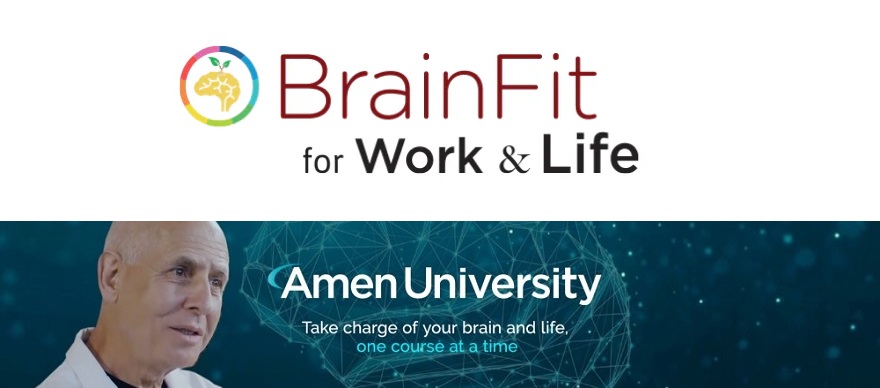
Many professionals can explain their stress in detail, overflowing inboxes, constant context switching, meetings that never end, family needs waiting at home, and a brain that feels foggy even after a full night in bed. What they often lack is a clear framework for strengthening the organ that has to manage all of it, the brain.
Dr Daniel Amen’s Brain Fit for Work & Life course is built for that gap. It is an eight module, roughly three and a half hour training that pulls together core principles from neuroscience and Amen Clinics brain health work, then applies them directly to daily work and life. The goal is simple, to help you think clearer under pressure, use your energy more intelligently, and become more resilient without needing a personality transplant.
Contents
What Brain Fit For Work & Life Is Trying To Solve
The promotional language talks about productivity and resilience, but underneath that is a concrete problem. Many workplaces run on people whose brains are overstimulated, underslept, and pulled in too many directions. Over time, that combination erodes focus, motivation, mood, and decision quality.
Symptoms That Show Up Before Burnout
Dr Amen and his team highlight early warning signs that your brain is struggling with how you work. These include trouble concentrating on one task, constant multitasking, emotional reactivity, a sense of dread on Sunday nights, heavy reliance on caffeine to function, and difficulty switching off after hours. None of these automatically mean illness, but together they point toward a brain that needs better support.
Brain Fit for Work & Life treats these issues as brain health problems before they become full burnout or clinical conditions. That framing matters. It shifts the conversation from personal weakness to practical changes you can make to help your brain function better.
For Leaders And Individual Contributors
The course is positioned for executives, managers, and motivated professionals, but the core tools apply to anyone whose work relies on attention and judgment. Whether you lead a team or simply want to handle your own workload more sanely, the ideas are the same, healthier brains make better decisions, respond more calmly, and are easier to work with.
How The Course Is Structured And Delivered
Brain Fit for Work & Life is a fully online course hosted by Amen University. It includes eight neuroscience driven modules, nine video lessons, and around three and a half hours of total content. You can move at your own pace, and there are printable tools to apply concepts between lessons.
Eight Modules With A Clear Arc
Each module tackles one piece of the work and life puzzle. Early segments cover basic brain functions in plain language and connect specific brain regions to everyday capacities such as focus, motivation, emotional control, and flexibility. Later modules turn to habit building, workplace communication, stress strategies, and work life balance.
The content is intended to be taken in order, since later tools build on earlier concepts. That said, once you complete the course, you can return to individual modules as needed, for example before a busy season at work or during a period of high stress at home.
Short Lessons With Support Materials
Instead of long lectures, the program breaks material into shorter video segments so that you can watch one or two lessons in a sitting. Alongside the videos, you receive a quick start guide, workbook pages, and checklists. These resources help you capture personal insights, track habit changes, and translate ideas into concrete actions.
Participants who finish the course receive a certificate of completion, which can be useful for professional development records, though it is not a clinical or coaching credential.
The Brain Based Framework Behind Brain Fit For Work & Life
The course does not treat productivity as a matter of time hacks or willpower alone. It roots its strategies in a brain centered framework that Dr Amen uses across many of his programs.
The Four Circles Of Brain Health
One of the central tools is the Four Circles model, which looks at your life through four lenses, biological, psychological, social, and spiritual. The course applies this directly to work and life:
- Biological: How your brain and body are functioning, including sleep, nutrition, movement, and medical issues.
- Psychological: Your thought patterns, beliefs, and unhelpful mental habits that show up under stress.
- Social: The people around you at work and at home, and how those relationships influence your brain.
- Spiritual: Your sense of purpose, values, and connection to something bigger than your current to do list.
Brain Fit for Work & Life uses this model to show that strained performance is rarely just a time management problem. It is often a sign that at least one circle is neglected or overloaded.
Key Brain Regions And Everyday Performance
The course also introduces a simple tour of key brain regions and the roles they play in work and life. For example, the prefrontal cortex is described as the internal chief executive that manages planning and impulse control, the anterior cingulate as the gear shifter that helps you move between tasks and ideas, the basal ganglia as the motivation and anxiety center, and the limbic system as a major mood hub.
Understanding these regions is not about turning you into a neuroscientist. It is about giving you language to notice patterns. If you constantly procrastinate, overreact, or obsess, you can start to think in terms of which brain systems might be under strain and what habits support them.
Key Skills And Strategies You Practice In The Course
Beyond general education, Brain Fit for Work & Life teaches practical skills that you can use the same day you learn them. These skills are aimed at sharpening clarity, improving productivity, and strengthening resilience.
Protecting Your Brain To Protect Your Work
One repeating message is that success at work starts in your brain, not in your calendar. The course covers how sleep, hydration, food, exercise, and substances affect attention, mood, and decision making. You learn why certain choices, such as regular movement, steadier nutrition, and consistent sleep windows, act as performance multipliers instead of optional self care.
You are encouraged to identify one or two biological changes that would have the highest payoff for your brain, then design small, realistic adjustments, rather than attempting a full lifestyle overhaul overnight.
Changing Thought Habits That Sabotage Performance
Dr Amen spends time on mental habits that interfere with clear thinking under pressure. This includes perfectionism, all or nothing thinking, predicting catastrophe, and mind reading coworkers or bosses. The course invites you to write out your common automatic thoughts, question their accuracy, and practice more balanced alternatives.
Over time, this can reduce emotional reactivity and help you stay grounded in stressful situations, which is central to both leadership and personal effectiveness.
Using Brain Smart Strategies For Focus And Productivity
The course also addresses attention in a practical way. You learn why constant multitasking drains your brain, how to structure work into focused blocks with breaks, and how to design your environment to reduce unnecessary distractions. Simple tactics, such as batching similar tasks, limiting digital interruptions, and aligning important work with your highest energy times, are tied back to how your brain manages resources.
This is less about squeezing more tasks into a day and more about doing the right tasks with a brain that is actually ready for them.
Building Resilience With The Four Circles
Resilience in the Brain Fit framework is not just pushing through. It means having enough biological reserve, psychological flexibility, social support, and sense of meaning to adapt when things go wrong. The course guides you to audit each circle and choose specific steps, such as improving a relationship, clarifying boundaries, revisiting values, or scheduling genuine rest, that strengthen your capacity to recover from stress.
Because the model is flexible, it can be applied to both workplace projects and personal challenges without needing to learn a new system each time.
Who Brain Fit For Work & Life Is Best Suited For
Although anyone interested in brain health can watch the course, it tends to resonate most with a few groups.
- Leaders and managers who want a practical language for brain health that they can bring into team culture, performance conversations, and wellness initiatives.
- Professionals in demanding roles who feel mentally stretched and want tools that go beyond generic stress tips.
- HR and learning teams looking for an evidence informed program to support employee well being and retention.
- Individual contributors who are serious about personal growth and want to align habits with how their brains actually work.
The course is not a clinical treatment and does not replace therapy, medical care, or occupational support for people already in crisis. Instead, it is best used as an educational and preventive framework, or as a complement to existing care.
Getting Real Value From Brain Fit For Work & Life
Like any training, the impact of Brain Fit for Work & Life depends on how you engage with it. Watching all eight modules over a weekend and then returning to old patterns is unlikely to change much. A more effective approach is slower and more deliberate.
- Schedule learning time. Treat modules like meetings with yourself. Put them on your calendar and protect the time.
- Apply a few tools at a time. From each module, choose two or three specific actions to test before you move on.
- Use the workbooks. Fill out the quick start guide and checklists honestly. They help you see patterns and progress.
- Share the framework. Talk about concepts such as the Four Circles or brain based habits with colleagues or family so they become shared language, not private theory.
- Connect it with your health care. If you already work with a clinician or coach, let them know what you are learning so that lifestyle, brain habits, and any treatment plan can support each other.
Handled in this way, Dr Amen’s Brain Fit for Work & Life course can become more than a one time professional development task. It can act as a framework for building a brain that is better able to focus, lead, create, and stay steady under pressure, across both work and the rest of your life.

